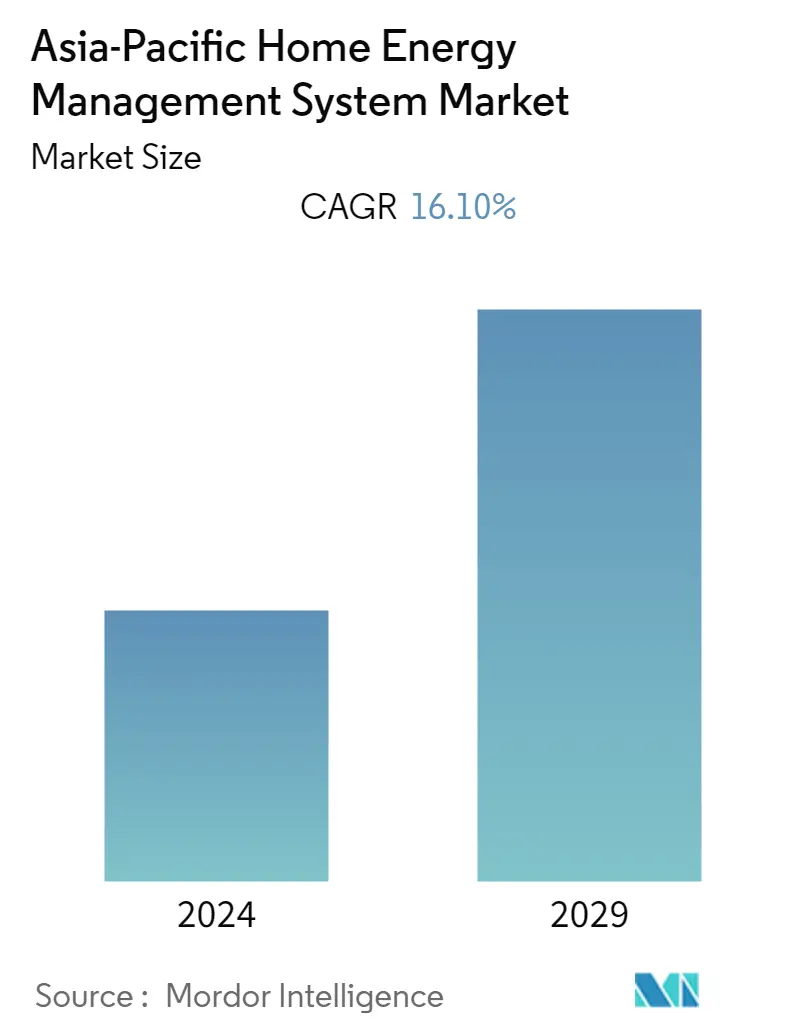Market Size of Asia-Pacific Home Energy Management System Industry

| Study Period | 2019 - 2029 |
| Base Year For Estimation | 2023 |
| Forecast Data Period | 2024 - 2029 |
| Historical Data Period | 2019 - 2022 |
| CAGR (2024 - 2029) | 16.10 % |
| Market Concentration | Medium |
Major Players
*Disclaimer: Major Players sorted in no particular order |
Need a report that reflects how COVID-19 has impacted this market and its growth?
Asia-Pacific Home Energy Management System Market Analysis
The Asia-Pacific Home Energy Management System Market is expected to register a CAGR of 16.10% during the forecast period(2024-2029).
The Asia-Pacific home energy management system market is primarily growing due to rising awareness of energy management and rising investment in smart grids. According to IFSEC Global, China recently invested USD 75 billion in electricity grids.
- With rapid technological advancements, like network communication, bidirectional communication mediums, information infrastructures, energy conservation methodologies, and various techniques, home area networks (HANs) experienced a revolutionary change in numerous areas of power consumption domains, like energy saving at consumption premises and electricity usage patterns.
- For instance, in January 2022, Google launched Nest Hub's 2nd generation in the Indian market. The company claims to offer an improved audio experience with 50% more volume than the original hub and a third mic for better Google Assistant response. Featuring a 7-inch color display, this smart display doubles up as a digital photo frame.
- Furthermore, due to increasing concern about the efficient use of energy, there is an expanding focus on installing energy-saving devices in households. Energy management systems are cost-effective in all residential buildings, regardless of national energy prices, usage, or climatic factors. Thus, they are increasingly being adopted into homes.
- Various companies are innovating new solutions as part of their business expansion. For instance, in April 2022, Samsung Electronics partnered with international technology company ABB to expand Samsung SmartThings integration into more homes and buildings. Further, due to this collaboration, Samsung may strengthen its home IoT solution in the residential and commercial construction markets by combining smart home solutions with SmartThings for more advanced, economical, and energy-efficient solutions for monitoring and controlling homes and buildings.
- Furthermore, the hardware components of home energy management systems cost much more than the software and service components, which may further hamper the studied market's growth. In addition, for maintenance, the need for more skilled laborers across the region is expected to increase costs as most of them have to travel down to the service areas and resolve issues. However, the growing focus on remote maintenance may reduce the cost burden during the forecast.
- Since the novel COVID-19 was declared a pandemic, most firms and plants were closed or were under severe restrictions. On the other hand, energy consumption in homes increased drastically. However, power and energy consumption declined overall, mainly due to the break in manufacturing activity in China, India, and Japan. Nevertheless, relaxation of the restrictions was apparent in the months ahead. Given the government's initiatives to decrease energy consumption, the region is likely to create opportunities over the forecast period.
